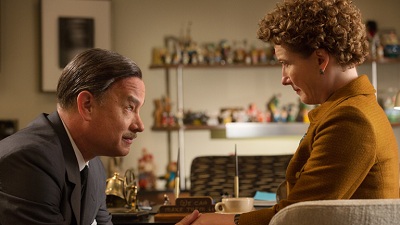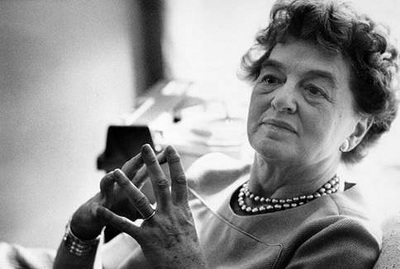In search of the Father with Mary Poppins
Cinema and memory have a similar effect on the truth. They clean it and make it sparkle to make it more bearable.
28 MARCH 2018 · 17:00 CET

Disney has announced that it will release a sequel to Mary Poppins next Christmas in a film set 20 years after the original film. Travers’ dark books – on which Disney based the character – are very different, but the film “Saving Mr Banks” showed us the problems that the author had with this project.
What is surprising is that it doesn’t all end there. It makes us analyse how fiction answers a reality, even if it is traumatic. It even makes us think about the strange way in which we create the memories of our loved ones, despite their evident imperfections.
Disney’s original film, which has now celebrated its fiftieth anniversary, won several Oscars – including the Oscars to best film and best actress, for Julie Andrews–. It was released in 1964. I had only just been born that summer, but I can’t begin to count the number of times that I have seen the film in cinemas, on VHS or DVD. And I haven’t yet tired of reading the comic. When I was little, I often listened to an album which contained part of the illustrated story and the text of some of the songs. I can still sing “supercalifragilisticexpialidocious/ Even though the sound of it is something quite atrocious/ If you say it loud enough, you'll always sound precocious”…
I suppose that there are few people that don’t know the story, but for those who have never stopped being children at heart – some of us never grow up! –, let me remind you that it is the musical story of a family living in Edwardian London: the Banks. The father is a severe but loving banker, who has little time for his children. The mother has an active social life and the song composers imagined her as a Suffragette. They were the ones who suggested taking Travers’ novels from the 1930s back in time to the beginning of the twentieth century.

This marvellous nanny unites magic and good sense, but she is so surprising that the children always get to the end of the day without really knowing what has happened to them. One might think that she and Bert will end up substituting the parents, but that doesn’t happen. At the end they unite and redeem the family.
MARY POPPINS’S BAD MOTHER
Many have seen in the name Mr Banks as a criticism of capitalism. This, in part, is true. Travers had socialist, feminist and also pretty esoteric ideas. She was a solitary woman, unable to connect with anyone emotionally. She was single and later adopted a boy. She followed the teachings of Gurdjieff, a Russian guru who mixed oriental ideas with early century European occultism. The children in the books speak to the sun, the wind and animals, in wonder at the cosmic unity of the world. At one point the stars come down to Earth, and in another episode Mary Poppins is greeted as a goddess in a zoo.
In this sense, Walt Disney was the complete opposite to Travers. At least, that is the image that Tom Hanks gives us in “Saving Mr Banks”. This image is far removed from the dark tales that have recently grown up around him, as “Hollywood’s Dark Prince”: sexist, racist, anti-Semitic and a persecutor of communists. There are many stories about him that have no basis in reality. The most famous of these is that his body was frozen after his death, although his ashes are actually in the Glendale cemetery. Most of these stories simply reflect conservative ideas shared by most North-Americans at that time.
The recent film by Walt Disney Pictures, tells of the clash between the irritating writer, played by Emma Thompson, and that “snake charmer”, the father of Mickey Mouse. The film by John Lee Hancock gives the false impression of being a special for the anniversary of the classic film directed by Robert Stevenson – a TV professional who produced Disney films in the 1960s and 70s–, who has nothing to do with the “making-ofs” found on the DVD. Neither is it a musical comedy, nor a romantic story.
SAVING MR BANKS
This film is about the clash between two people in 1961, shown in parallel to what occurred in Australia in 1906. Australia is where the author was born at the turn of the century. She was the daughter of a failed banker – the character played by Colin Farrell, who tries to drown the pain of his illness with alcohol and who dies when she is only eight. In the film, Travers unearths her memories of him when she is alone in a hotel in Los Angeles, as they try to convince her to let them make a film about Mary Poppins.
Travers went to the United States for two weeks, to see what they wanted to do with her character. Disney had been trying to buy the rights to her book since 1938, but she refused until 1959, when the sales of her books had started to wane and she needed more money. The condition was that she had to approve the script. This became a nightmare for the writers, the Sherman brothers. She didn’t like their ideas one bit: she thought that the songs were horrible and the last thing she wanted was to see dancing penguins.

The memory of her father arouses contradictory feelings in Travers, who associates him with the character of Mr Banks. She loved her father, but he disappointed her. On the one hand, she tries to be faithful to him and defend him in the eyes of the world, but she also knows that his critics were right, at least in part. It is obvious that she wrote as a way of dealing with the pain of her childhood. There is a scene in the original film when the children, Jane and Michael, run away from the bank. They tell Bert that they are afraid of their father; they think that he doesn’t love them.
The chimney sweep played by Van Dyke tells the children that their father loves them deeply. He explains it to them with a song. He tells them about how their father goes to the bank every day; the place is cold and all his efforts go unappreciated. Mr Banks is the prototype father that we see in films; neither a hero nor a villain; he is grey, trapped in his daily routine and unable to spend enough time with his children.
IN SEARCH OF THE FATHER
I don’t know how much truth there is to this story, but I don’t care about truth. It is marvellous to think that Travers found her father in the character of Mr Banks. The author comes up against Disney’s childish world, to defend the more sensitive, complex and mature character of her father. By “saving Mr Banks”, she recovers the figure of a father, full of imperfections, allowing herself to love those imperfections.

Mr Disney’s “happy end” is that he at last manages to make the film that he had been trying to make for such a long time. He was so proud of the project that he invested more in that film than he had in any previous production. It is the only film for which he had been to the premiere since “Snow White and the Seven Dwarfs” in 1937. Travers left the premiere in tears. Apparently it was out of rage at what Disney had done to her character, but the film shows it as a sort of catharsis. The fact is that she did not allow a sequel to be made.
The character played by Hanks is that of a charming man, who tries to seduce her by taking her to Disneyland. This is however too reminiscent of her father, who would fascinate and surprise her with stories of a magical world, which were of no help in real life. Towards the end, Walt says to Travers: “That's what we storytellers do. We restore order with imagination. We instill hope again and again and again”. Disney is doing something similar here with the story about Walt, Travers and Mary Poppins; something that the author would have hated.

This raises the question of truth. “Saving Mr Banks” is based on a real story but, like all the adaptations, it glamorises a set of characters whose actions are transmitted in easy to digest scenes. The emotional twists come at the right moment and it all leads to a happy ending. Cinema and memory have a similar effect on the truth. They clean it and make it sparkle to make it more bearable.
Francis Schaeffer called the story of the Gospel, “the true truth”, to differentiate it from so many other truths that we form in our minds. He said that the historical Christianity that we find in the Bible, is not only the truth in a doctrinal sense, but it is literally true. Faced with the dictatorship of “relativism” we not only need to aspire to Schaeffer’s clarity and precision, but also his compassion.

At the end of his life, this thinker left us a short book called “The mark of the Christian”, which defends what he calls “the final apologetic”. On the basis of the words of the Gospel of John (13: 34-35), he says that Jesus has given the world the right to test the authenticity of our faith, through the love that we have for each other. For him that meant “showing love to our brothers in the midst of our differences– great or small– loving our brothers when it costs us something, loving them even under times of tremendous emotional tension, loving them in a way the world can see”. He concludes, “Only with this mark may the world know that Christians are indeed Christians and that Jesus was sent by the Father.”.
The God that the Bible reveals to us is infinite and personal. Both realities are included in the description of God as Father that is given to us in the New Testament. He is the Creator but he is also the Father of Jesus Christ.
He is a Father like no other. He is omniscient, but his love transcends that of the most loving father on this Earth. In Jesus Christ, we see him as the One we can trust and who can heal any wound. He is beyond our memories.
Published in: Evangelical Focus - Between the Lines - In search of the Father with Mary Poppins
